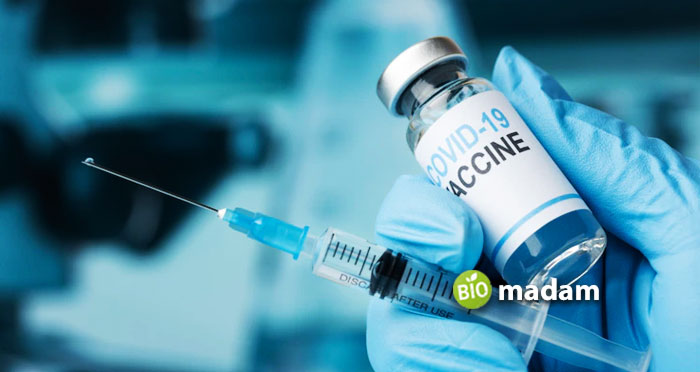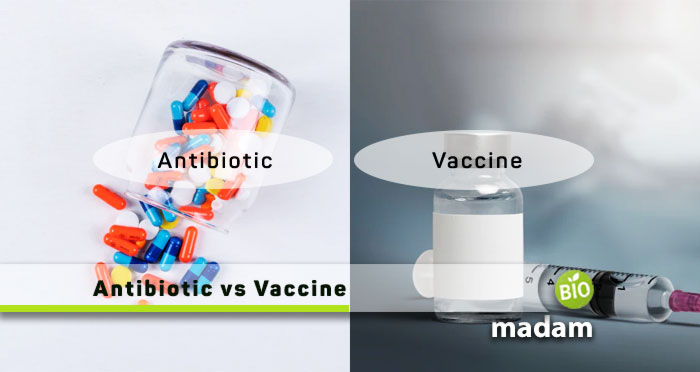Recently updated on January 3rd, 2026 at 06:21 pm
Vaccines and antibiotics are essential to protect against diseases and help maintain good health. People have been using them for decades to prevent and treat illnesses. Today, researchers are working on improving vaccines to reduce the need for antibiotics. Both play a major role in saving you from bacterial and viral diseases. Despite this key role, they are not entirely the same in structure or function. Let us tell you about the differences between antibiotics and vaccines in detail.
Comparison Table
| Factors | Antibiotic | Vaccine |
| Definition | Compounds acting against bacteria | Killed or attenuated antibody-inducing microbes |
| Types | Gram negative, gram positive, and broad spectrum | Attenuated, inactivated, subunit, conjugate, toxoid |
| Source | Natural, synthetic or semi-synthetic compounds | Disease-causing microbes |
| MoA | Inhibiting bacterial activity | Producing antibodies |
| Side Effects | Nausea or diarrhea | Allergic reaction |
| Examples | Penicillin and tetracycline | Polio, influenza, chicken pox |
What are Antibiotics?
The word antibiotic is a combination of two parts; anti and biotic. Anti means “against,” whereas biotic translates to “related to life.” Antibiotics are used to kill living organisms (bacteria) that cause diseases.
Medline Plus defines antibiotics as “Antibiotics are medicines that fight bacterial infections in people and animals. They work by killing the bacteria or making it hard for them to grow and multiply.”
These could be synthetic or natural compounds that have the ability to act on particular bacteria and prohibit their activity. Moreover, antibiotics are observed to produce side effects like constipation, diarrhea, and stomachache.
How do Antibiotics Work?
Antibiotics work by either stopping bacterial growth or killing them altogether. They are known as bacteriostatic and bactericidal.
Bactericidal Antibiotics
They act on the bacterial cell wall and kill it. Thus, the bacteria are no more effective and do not cause any harm.
Bacteriostatic Antibiotics
The mechanism of action of bacteriostatic antibiotics is different from bactericidal. Instead of killing the bacteria, they disrupt multiplication and growth to stop the infection or diseases caused by such microbes. Bacteriostatic antibiotics typically inhibit the protein synthesis pathway to control bacterial action.

Types of Antibiotics
There are seven basic antibiotics classes, but they can all be divided into two major types; gram -ve and gram +ve. They act on different kinds of bacteria causing various diseases. The basic difference between the two is the presence of gram-negative and gram-positive cell walls.
Gram-Negative Bacteria
Gram-negative bacteria refer to bacteria with a gram-negative cell wall. They do not retain crystal violet stain and stain red. The gram-negative cell wall is double-layered and wavy without teichoic acid. It contains lipopolysaccharides with 20% – 30% lipid content. Examples include E. Coli, Klebsiella, etc.
Gram-Positive Bacteria
On the other hand, gram-positive bacteria retain the crystal violet color of the stain. They have low lipid content, and teichoic acids are absent. Gram-positive cocci include Staphylococcus and Streptococcus.
Use of Antibiotics
Antibiotics treat infections and diseases caused by bacteria, including;
- Dental infections
- Whooping cough
- Strep throat
- Ear infection
- Skin infection
- UTI
- Kidney infections
- Meningitis and encephalitis
- Pneumonia

What are Vaccines?
Vaccines are defined as “a preparation that is used to stimulate the body’s immune response against diseases. They are typically prepared from half-killed or live viruses and bacteria.”
Vaccines and antibiotics are different from each other despite contributing to better health. They are administered to a healthy individual as a prophylactic treatment to prevent disease.
How do Vaccines Work?
Antigens and pathogens often enter the body and cause illnesses. When the foreign entity enters the body, it activates an active immune response. The immune cells in the body, including macrophages, B-cells, and T-cells, act on the pathogen to avoid prolonged damage. However, sometimes the immune response is intense and may be fatal.
Vaccines use attenuated (half-killed) bacteria or viruses to produce different antibodies. The production of antibodies by antigens prepares your body for the same microorganism in the future. This time your body is ready to fight the pathogen without waiting for the antibodies to develop. You may get infected, but vaccination ensures a quicker recovery.

Types of Vaccines
Vaccines are of multiple different types depending on how the pathogen is inserted into the body. Sometimes, they might be half-killed, killed, conjugate, or subunit. We have explained each of the terms before for better understanding.
Attenuated Vaccines
Attenuated vaccines are also known as live bacteria that contain living, weakened bacteria. They produce the closest response to what living bacteria would cause. MMR and chickenpox are the most common attenuated vaccines.
Inactive Vaccines
Inactive vaccines contain germs inactivated or killed to activate the immune cells for immediate response. The polio vaccine is one of the most widely used non-live or inactive vaccines.
Conjugate Vaccines
Conjugate vaccines work against antigenic bacteria that contain an outer polysaccharide covering. They help the coated antigen to induce an adequate immune response by identifying the antigen.
Toxoid Vaccines
Toxoid vaccines produce toxins, usually exotoxins, in the body that activate the immune system to fight off illnesses. These weakened toxins inserted into the body are known as toxoids. Tetanus and diphtheria toxoids are found in the DTaP vaccine.
Subunit Vaccines
Subunit vaccines include a part of the bacteria or the virus instead of the whole antigen. DTaP vaccines contain subunit vaccines for whooping cough. These vaccines have lesser side effects.
Use of Vaccines
Vaccines cannot cure all diseases, but they are used against numerous diseases by producing different antibodies against the specific antigens. Some of the commonly used vaccines include:
- Hepatitis A & B
- Rotavirus
- MMR
- Polio
- Diphtheria
- Chickenpox
- Shingles

Difference between Antibiotics and Vaccines
Definition
Antibiotic
Antibiotics are natural or synthetic compounds that treat infections caused by fungi, bacteria, protozoans, and other such parasites.
Vaccine
Vaccines are inactivated or dead organisms that produce active immunity against particular diseases.
Types
Antibiotic
Antibiotics are classified into three types; gram-negative, gram-positive, and broad spectrum. There are eight basic antibiotic classes: penicillin, cephalosporin, sulfonamides, macrolides, fluoroquinolones, tetracycline, aminoglycosides, and carbapenem.
Vaccine
Vaccines are of numerous types depending on their inoculation method. Vaccines may be attenuated, inactivated, conjugate, subunit, toxoid, and DNA.
Source
Antibiotic
Antibiotics can be natural, semi-synthetic, or natural compounds.
Vaccine
Instead, vaccines are live or attenuated antigens and pathogens to produce antibodies.
Mechanism of Action
Antibiotic
Antibiotics fight disease-causing bacteria by restricting their activity or killing them.
Vaccine
On the contrary, vaccines act against viruses and antibiotics by imitating the antigen to activate the immune system.
Side Effects
Antibiotic
Antibiotics typically have side effects like nausea, diarrhea, and allergic reactions.
Vaccine
However, vaccines do not have any side effects as such besides possible allergic reactions.
Examples
Antibiotics
Examples of antibiotics include cephalosporin, penicillin, tetracycline, etc.
Vaccines
Commonly used vaccines are polio, MMR, and hepatitis A.
The Bottom Line
Vaccines and antibiotics have been used for protection against diseases for a long time. Antibiotics halt the activity of disease-causing bacteria, whereas vaccines protect and induce active types of immunity. They both contribute to fighting illnesses. However, the basic difference between antibiotics and vaccines lies in their administration time and mechanism of action. It is important to remember that antibiotics act on bacteria, fungi, and protozoans and do not kill viruses. On the contrary, vaccines work on bacterial as well as viral diseases.
FAQs
Can you take antibiotics with probiotics?
Antibiotics and probiotics are often taken together to replenish body nutrients. Sometimes, antibiotics kill good bacteria in our bodies. Thus, taking probiotics can help balance the number of healthy gut bacteria. However, some antibiotics are also effective against fungal infections and protozoans.
What are broad-spectrum antibiotics?
Broad-spectrum antibiotics act against numerous infection-causing bacteria comprising gram-negative and gram-positive. Common broad-spectrum antibiotics include ampicillin, doxycycline, minocycline, etc.
Can I take antibiotics after I get a vaccine?
You can take any type of drug, like analgesics or antibiotics, after vaccination as it does not affect the working of the vaccine. If the vaccine does not protect against the disease, do not hesitate to take an antibiotic as prescribed.
Can you use antibiotics and vaccines for allergies?
Antibiotics and vaccines do not help clear up allergic reactions. Take anti-histamine for severe hypersensitivity reaction if needed.
What is herd immunity in terms of Covid-19?
Herd immunity refers to immunity against a particular disease in a whole population. It either occurs due to an epidemic or through mass vaccination. WHO emphasizes achieving herd immunity by immunizing the population through vaccination.

Anna has completed her degree in Pharmacy from the University of Hawaii. She is serving as a research assistant in a pharmaceutical company. She had a great interest in writing blogs, traveling to different parts of the US, and trying delicious recipes in her spare time.

